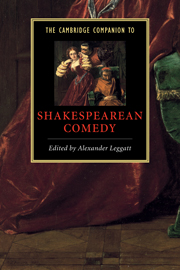5 - Popular festivity
from Part 1 - Shakespeare and comic tradition
Published online by Cambridge University Press: 28 May 2006
Summary
In Shakespeare's day, long after the Reformation, the calendar as established by the Church, with its series of days consecrated to saints and its fixed and movable feasts, still played a role of major importance. It constituted a matrix of time, the effect of which was to subordinate events of secular life to those of the sacred cycle of the year (the movable feasts of the Christian liturgy governed by the Easter cycle and ranging from Shrove Tuesday to Corpus Christi) and to commemorate a host of popular beliefs and folkloric traditions that had developed over centuries. The year was, by and large, divided into two halves: the winter or sacred half, ranging from Christmas to 24 June (which corresponded to Midsummer but also to the latest possible date for the feast of Corpus Christi); and the summer half, with its mainly agrarian feasts and host of local and occasional celebrations, which went from 25 June to Christmas.
Shakespeare, as a playwright, is unique in the place and importance he ascribes to popular festivity and holidays, thus giving what might have been regarded as “airy nothing” a “local habitation and a name” (A Midsummer Night’s Dream, 5.1.16–17). He indeed includes all and sundry, court and country, in his festive kaleidoscope firmly set on the fertile ground of the variegated traditions and customs of “Merry England,” and this without nostalgia or satire.
- Type
- Chapter
- Information
- The Cambridge Companion to Shakespearean Comedy , pp. 64 - 78Publisher: Cambridge University PressPrint publication year: 2001
- 2
- Cited by



